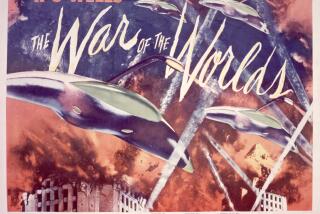The Best and the Worst of ‘50s Sci-Fi
- Share via
The 1950s, with the Cold War and the Communist scare, had everyone worried that Armageddon was just around the corner. Because of the hysteria over the Bomb and those who might use it against the United States, most filmmakers were forced to deal obliquely with the political and social issues of the day. One of the results was that they spawned a series of sci-fi films that looked at authority figures as either lynch mob or savior.
MCA Universal has just released a laser-disc collection of four of Universal’s most popular movies in the genre in a boxed set, “From Universal Pictures’ Golden Age of Science Fiction Thrillers” ($100). None has been available on laser previously, although they have been out separately on videotape.
While “It Came From Outer Space,” “Tarantula,” “The Mole People” and “The Deadly Mantis” may not have the digital special effects and technical wizardry of “E.T.,” “Alien,” “Close Encounters of the Third Kind” or “Star Wars,” there’s enough going on to see where some of today’s big-deal filmmakers found some inspiration. With the exception of “The Mole People,” these black-and-white films use just enough dramatic effects to make these outer space visitors and giant insects believable and quite scary. The stereo sound is quite realistic, whether capturing the eerie music surrounding the aliens or the buzzing wings of the Deadly Mantis in flight.
A nicely illustrated brochure with artwork from the original productions and detailed liner notes, plus well-delineated chapter stops help compensate for squeezing the four films onto three discs. One odd bit of packaging is that the only way you’ll know what film is on what disc is by consulting the brochure. The discs themselves do not specify which films they contain.
The best of the lot is “It Came From Outer Space,” the 1953 film based on a Ray Bradbury story that focused on a revolutionary concept: Aliens from outer space might be benign and not bent on destroying Earth. The film, directed by Jack Arnold and written by Harry Essex, stars Richard Carlson and Barbara Rush looking as if they thoroughly believe everything that is going on.
The desert--stark, mysterious and desolate--became the spot for these extraterrestrial visitors to make repairs to their damaged spaceship. But most of the populace fears the unknown; its first instinct is to destroy, not attempt to understand. This is the “Twilight Zone” concept of the mob against the good guys, of authority out to crush anything it doesn’t know.
The frightening makeup for the outer space visitors was done by Bud Westmore; Robert Boyle was art director. The film was originally shot to be shown in 3-D and its low-key use of the technology makes it one of the most effective 3-D films of the era.
If “Arachnophobia” kept you looking under your feet in 1990, 1955’s “Tarantula” will keep you looking toward the horizon for the biggest, nastiest spider yet put on film. John Agar and Mara Corday (or is it Carlson and Rush again in different costumes?) are among those tracking the giant creature created by scientist Leo G. Carroll’s growth formula gone awry. Henry Mancini did the atmospheric score that nicely adds to the tension, which remains intense from beginning to end.
John Agar also stars in the 1956 “The Mole People,” arguably one of the worst sci-fi films out of the Universal shop. It concerns a lost underground civilization of albinos who treat half-human creatures as their slaves. Among the oddest curiosities is USC’s revered Shakespearean scholar Frank Baxter, who could read T.S. Eliot’s “The Hollow Men” with aplomb, offering a serious prologue setting up the concept of a hollow Earth, where the mole people set up their bizarre shop.
“The Deadly Mantis” (1957), which opens with an equally odd documentary-like prologue that features a wall map of the world, finally begins in the stark, mysterious and desolate Arctic, where America’s Cold War Missile Defense system is tested by a giant praying mantis, frozen for millennia, that is unleashed on a frightened world. It’s the ultimate doomsday scenario: Only the U.S. military and scientists can save us from ultimate destruction.
Craig Stevens and William Hopper try to figure out how to stop the hungry insect as it makes its way south. The film offers good special effects and a deadly serious scenario that throws in great heaps of schoolbook science to offset the obligatory love story. The director was Nathan Juran, who under the name of Nathan Herz would unleash the original awful “Attack of the 50 Ft. Woman” on drive-in theaters.
More to Read
Only good movies
Get the Indie Focus newsletter, Mark Olsen's weekly guide to the world of cinema.
You may occasionally receive promotional content from the Los Angeles Times.










